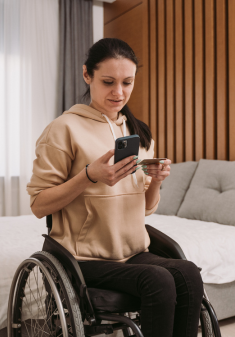The technology has transformed almost every aspect of our lives
And tourism is no exception. In this article we talk about technology and accessible tourism and is it for travellers with disabilities, the technology has led to a real revolution, enabling them to plan, book and enjoy your travel in a much more accessible way. From mobile applications or web sites that provide information on the accessibility of destinations, to innovations in hotels and transportation, the technology has made travel more comfortable and without barriers. Below, we explore the tools and technological advances, the more useful they are improving the experience of accessible tourism.
Mobile applications and websites: perfect combination between technology and accessible tourism.
One of the major advances that have facilitated the accessible tourism are the mobile apps. These apps allow travelers with disabilities plan and organize your trips, accessing crucial information about the accessibility of hotels, restaurants, transport and tourist attractions. Some of the applications are recommended:
- TUR4all: This website has become a reference in the tourism accessible, allowing users to search for information on accessible destinations all around the world. In addition, TUR4all offers the possibility for travelers to share their valuations, creating an active community that contributes to improving the quality of information on accessibility.
- Wheelmap: Perfect to find and share information about the accessibility of public spaces. Wheelmap is a collaborative tool that enables users to identify what places are accessible, partially accessible, or not accessible, based on the experience of other users.
- Be My Eyes: Although it is not specifically an application of tourism, Be My Eyes is very helpful for people with visual disabilities. This app connects people who are blind or have low vision with volunteers via video calls, who help them in real-time with tasks such as reading signs, or find directions in airports and train stations.
Technological innovations in airports, and transportation
Transportation is a crucial area in the travel experience for people with disabilities, and many airports and transportation are adopting technologies accessible to ensure that all the travelers to move around without difficulties. Among the main innovations are:
- Wheelchairs autonomous: Some international airports are already using electric wheelchairs autonomous allow travelers to move through the terminal without the need of assistance. These smart vehicles can be requested via the app and are able to guide the passenger to the boarding gate or any other location from the airport.
- Navigation systems for people with visual disabilities: Several airports and train stations have begun to implement a navigation system, auditory and tactile maps to help travelers with visual impairments. These systems provide instructions in real time, which allows them to move with greater independence.
- Public transport facilities: In cities such as Berlin, London, and New York city, the public transportation systems are increasingly equipped with ramps, lifts and visual cues and auditory. In addition, some mobile apps allow users to verify in real time if the transportation vehicles are accessible, significantly enhancing the experience of passengers with disabilities.

Technology in hotels and accommodations accessible
The hotels are also incorporating technological advances to ensure that travelers with disabilities to enjoy a comfortable and without problems. The innovations featured include:
- Smart rooms: In many hotels, the rooms are being equipped with technology for home automation that allows guests to control various aspects of your environment, such as light, temperature, and the curtains, using voice commands, or an app on your mobile phone. This is especially useful for people with reduced mobility, as it allows them to manage your stay-autonomous manner.
- Warning systems visual and auditory: Some rooms are adapted for people with hearing or visual disabilities, with systems of visual alert for emergency alarms, lights, turn signals, and systems of vibration for alarm clocks. These technologies ensure that all guests, regardless of their disability, they can feel safe and comfortable.
- Bookings accessible: Platforms such as Booking.com or Airbnb have added specific filters that allow users to search for accommodations accessible. These filters include options such as rooms with toilets, access ramps or lifts, making planning easier and more efficient.

Future: technology and accessible tourism.
The technological evolution is stopped, and it is likely that in the next few years, let’s look at new tools that will continue to improve the experience of accessible tourism. Some areas of innovation include:
- Virtual reality (VR): virtual reality has the potential to revolutionize the tourism accessible, enabling people with disabilities to explore virtually destinations, hotels, and attractions before you make decisions. This not only allows them to know the level of accessibility of the place, but also to experience the destination in advance.
- Artificial intelligence (AI): The AI is starting to be used in applications that provide personalized recommendations based on the specific needs of each user. These tools can suggest routes, activities and accommodations accessible in accordance with the profile of mobility or disability of the traveler.

TUR4all Travel is ready to capitalize on this trend, offering travel solutions that consider all accessibility needs, collaborating with tourism destinations and providers of services to improve the accessibility and ensuring that everyone can enjoy their travel without barriers.



